IAC80 Telescope
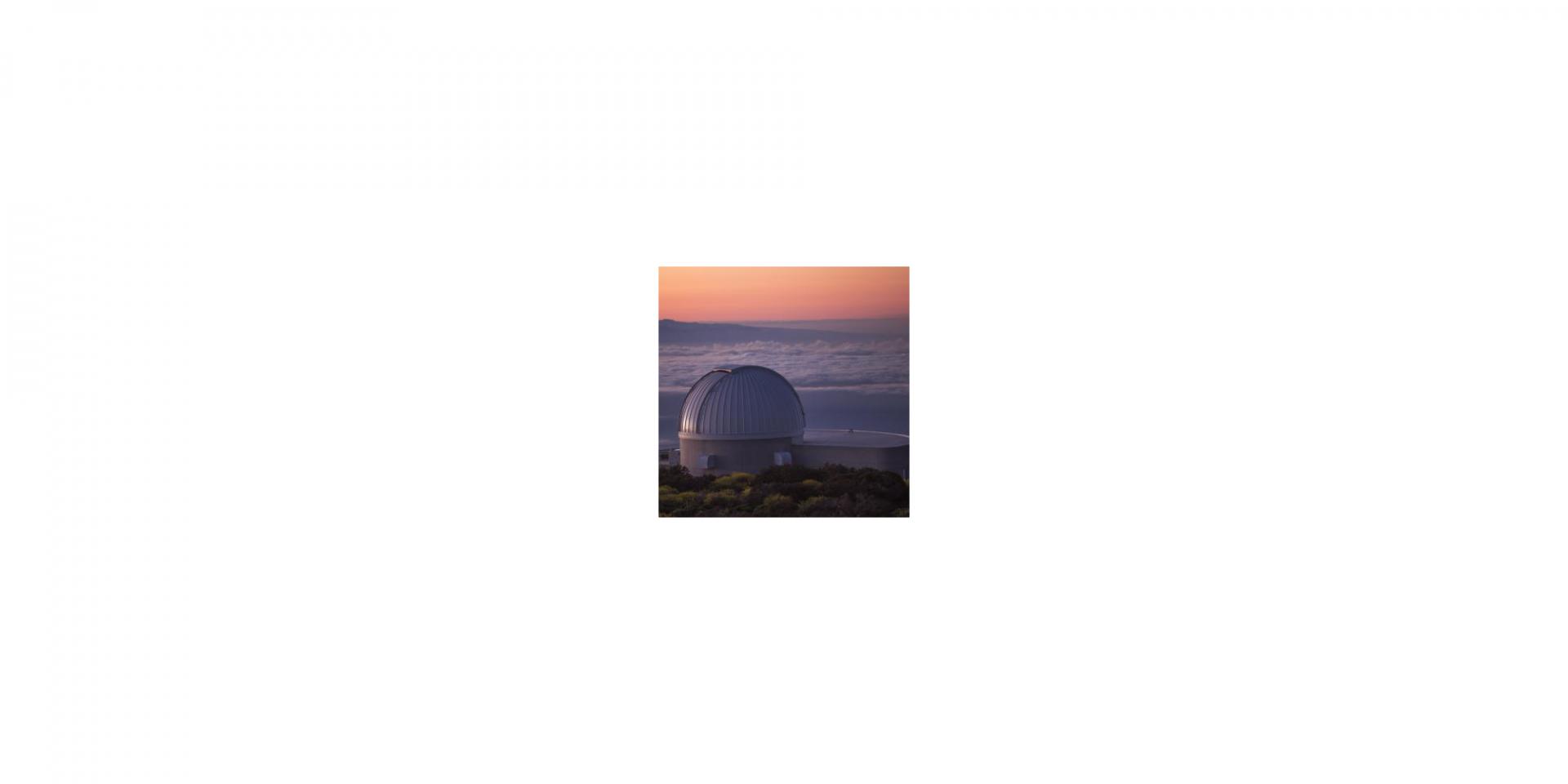

The IAC80 telescope, setted for observations in the optical, was fully designed and built by the Instituto de Astrofísica de Canarias (IAC) and it was the first of its class developed in Spain. In 1980 the IAC started its development and was finally installed at the OT in 1991. This telescope has an equatorial german mount, with an effective focal ratio of f/11.3, effective focal length of 9.02 m and a primary mirror of diameter 82 cm. The instrumentation is installed at its Cassegrain primary focus.
The IAC80 telescope is an ideal telescope for long-term programmes, collaborations with other telescopes, urgent observations in service or ToO observation modes, student practices and observational or instrumental test-bed. IAC80 is a key part of the Teide Observatory because of its versatility and availibity. Currently, the IAC80 is equiped with the wide field camera CAMELOT2.
The list of filters is currently under revision
IAC No. |
Spectral Range |
CWL[nm] |
Width[nm] |
Tmax(%)(1) |
Transmission |
Cosmetic(2) |
Size(3) |
Name(4) |
IAC No. |
|
| jpg | ascii | |||||||||
| 73 | — | 312.7 | 4 | 65.2 |
|
new | 50L | n73 | 73 | |
| 77 | — | 330.9 | 4.3 | 52.4 | new | 50L | n77 | 77 | ||
| 22 | [OII] cont. | 365.8 | 5 | 57.2 | V – H | (*) | 50D | n22[OII]ct | 22 | |
| 4 | [OII] | 372.5 | 5 | 54.2 | new | 50D | n4[OII] | 4 | ||
| 76 | [NeIII],OII, Heps | 397.3 | 6.9 | 61.1 | new | 50Lx8 | n76[NeIII] | 76 | ||
| 14 | — | 460.9 | 5 | 78.2 | new | 60D | n14 | 14 | ||
| 15 | HeII | 463.3 | 5 | 78.3 | det(O) | 60D | n15HeII | 15 | ||
| 80 | HeII | 468.3 | 3 | 76 | new | 60Dx6 | n80HeII | 80 | ||
| 66 | [ArIV], [FeIII] | 475.3 | 3 | 60.5 | C | C | new | 50D | n66[ArIV] | 66 |
| 5 | Hß cont. | 484.1 | 3 | 78.3 | new | 60D | n5Hbct | 5 | ||
| 10 | Hß | 486.5 | 3 | 79.3 | new | 60D | n10Hb | 10 | ||
| 65 | Hß | 487.5 | 6.2 | 63.7 | C | C | new | 50Dx6 | n65Hb | 65 |
| 13 | Hß red | 490.1 | 5 | 66 | new | 60D | n13Hbred | 13 | ||
| 1 | Hß red. | 493.5 | 4 | 80.7 | new | 60D | n1Hbred | 1 | ||
| 6 | [OIII] | 500.8 | 3 | 76.7 | new | 50Dx6 | n6[OIII] | 6 | ||
| 7 | [OIII] red. | 502.8 | 5 | 80.2 | det(O) | 60D | n7[OIII]red | 7 | ||
| 3 | [OIII] cont. | 505.8 | 5 | 78.3 | det(O) | 60D | n3[OIII]ct | 3 | ||
| 33 | [OIII] cont. | 506.5 | 2.5 | 76.3 | new | 60Dx6 | n33[OIII]ct | 33 | ||
| 9 | [OIII] red. | 510 | 5 | 80.6 | new | 60D | n9[OIII]red | 9 | ||
| 16 | [OIII] red. | 514 | 5 | 79.2 | new | 60D | n16[OIII]red | 16 | ||
| 8 | [OIII] red. | 518 | 5 | 66.5 | new | 60D | n6[OIII]red | 8 | ||
| 21 | [OIII] red. | 522 | 5 | 84 | det(O) | 60D | n21[OIII]red | 21 | ||
| 11 | [OIII] red. | 525 | 0.5 | — | det(O) | 60D | n11[OIII]red | 11 | ||
| 18 | — | 545.7 | 5 | 71.5 | new | 60D | n18 | 18 | ||
| 28 | — | 606.1 | 19.7 | 92.1 | new | 60Dx7 | n28 | 28 | ||
| 38 | [OI] cont. | 625.8 | 2.9 | 89.5 | new | 60Dx7 | n38[OI]ct | 38 | ||
| 37 | [OI] | 630.8 | 2.9 | 87.8 | new | 60Dx7 | n37[OI] | 37 | ||
| 27 | Ha cont. | 650.7 | 5 | 84.7 | new | 60Dx7 | n27Hact | 27 | ||
| 40 | Ha | 656.7 | 0.8 | 60 | scrat | 50Dx6 | n40Ha | 40 | ||
| 20 | Ha+[NII] | 657.1 | 5 | 91.1 | n20Ha[NII] | 20 | ||||
| 68 | Ha | 657.6 | 9.6 | 63 | C | C | new | 50Dx6 | n68Ha | 68 |
| 12 | Ha red. | 661.1 | 5 | 88.7 | (*) | 60D | n12Hared | 12 | ||
| 24 | Ha red. | 664.7 | 5 | 90.2 | new | 60Dx7 | n24Hared | 24 | ||
| 19 | Ha red. | 668.7 | 5 | 92.9 | (*) | 60D | n19Hared | 19 | ||
| 32 | [SII] | 671.7 | 0.8 | 65.9 | scrat | 60Dx5 | n32[SII] | 32 | ||
| 17 | [SII] | 672.3 | 5 | 92.5 | new | 60D | n17[SII] | 17 | ||
| 34 | [SII] | 673.5 | 1.1 | 59.7 | new | 60D | n34[SII] | 34 | ||
| 39 | Ha red. | 676.3 | 4.9 | 92.7 | new | 60Dx7 | n39Hared | 39 | ||
| 31 | Ha red. | 680.3 | 5 | 93.2 | new | 60Dx5 | n31Hared | 31 | ||
| 30 | Ha red. | 684.8 | 5 | 87.5 | new | 60Dx7 | n30Hared | 30 | ||
| 36 | Ha red. | 689.1 | 5 | 91.5 | new | 60Dx7 | n36Hared | 36 | ||
| 35 | Ha red. | 692.9 | 4 | 92 | new | 60Dx7 | n35Hared | 35 | ||
| 2 | Ha red. | 697.2 | 5 | 92.3 | new | 60D | n2Hared | 2 | ||
| 29 | — | 701.5 | 5 | 92.1 | new | 60Dx7 | n29 | 29 | ||
| 74 | — | 744.2 | 13.9 | 90.2 | (*) | 50L | n74 | 74 | ||
| 85 | 750 Cont | 749.25 | 11.5 | 87.5 |
|
new | 50D | n85con | 85 | |
| 78 | K | 769.1 | 24.3 | 95.5 | new | 50L | n78K | 78 | ||
| 83 | K (LGS-OGS) | 769.1 | 10 | ? | new | 50Lx6 | n83K | 83 | ||
| 75 | — | 779.8 | 24.9 | 91.3 | new | 50L | n75 | 75 | ||
| 81 | 824 Ch4blue | 823.6 | 13.2 | 81.2 | new | 50Lx6 | n81_824 | 81 | ||
| 84 | 890 Ch4cen | 890.25 | 12.5 | 86 | new | 50D | n84_890 | 84 | ||
| 82 | 914 Ch4red | 913.8 | 13.5 | 90.4 | new | 50Lx6 | n82_914 | 82 | ||
| 25 | [SIII] cont. | 948.1 | 3 | 84.3 | new | 60Dx6 | n25[SIII] | 25 | ||
| 23 | [SIII] | 952.9 | 3 | 81.8 | new | 60Dx6 | n23[SIII] |
23 |
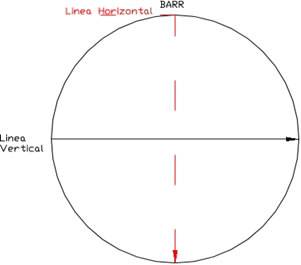
(1) All these are circular filters 60mm diameter or 50mm side (square) or diameter (round). The transmission of each filter was measured by sampling in two different lines, horizontal and vertical, crossing the center filter to detect possible irregularities. Data were taken every 5 mm. Sampling took place in the whole visible range over a certain length at the ends to evaluate their performance. The sampling interval was 0.1 nm and a bandwidth of 0.3 nm (except for IAC # 26, which was 0.5 nm, and IAC IAC # 32 and # 34, with a sampling of 0 , 02 nm with a bandwidth of 0.07 nm). The transmission measured is ratiometric, that is, no corrections were applied onphotopic or scotopic correction curves. The measurement temperature for all filters was 20 º C.
(2) (det) label indicates that filter is somewhat damaged and is going to be replaced soon, (O) label indicates that a new filter have been requested, (scrat) label indicates that the filter is somewhat scratched.
(3) 50L: squared filters 50mm side.
50D: circular filter of 50mm diameter (proper for FASTCAM).
60D: circular filters 60mm diameter.
Filter thickness is indicated only if it is larger than 5mm.
(4) Filter name in the image header.
(*) Please, contact with GAS (ttnn_a [at] iac.es (ttnn_a[at]iac[dot]es)) if you want to use these filters.
|
Name |
CWL [nm] |
Width [nm] |
Tmax (%) |
Transmission (ASCII) |
| U | 365.75 | 57.70 | 64.77 | U |
| B | 433.45 | 97.50 | 71.17 | B |
| V | 537.40 | 84.60 | 86.75 | V |
| R | 627.25 | 127.30 | 82.04 | R |
| I | 872.20 | 298.00 | 93.70 | I |
|
Name |
CWL [nm] |
Width [nm] |
Tmax (%) |
Transmission (ASCII) |
| u’ | 305.05 | 62.30 | 79.28 | u’ |
| g’ | 475.80 | 143.40 | 90.21 | g’ |
| r’ | <623.10 | 142.60 | 94.96 | <r’ |
| i’ | 770.60 | 156.40 | 92.68 | i’ |
| z’ | 966.20 | 267.60 | 96.62 | z’ |
|
Filter |
CWL [nm] |
Width [nm] |
Tmax (%) |
Transmission (JPG) |
| U |
346,75 |
31,5 | 83,68 | U |
| V | 412,00 | 20 | 91,52 | V |
| B | 465,5 | 17,0 | 89,52 | B |
| Y | 544,75 | 23,5 | 91,90 | Y |
Filters for TCP |
|
Name |
CWL [nm] |
Width [nm] |
Tmax (%) |
||
|
U |
364.25 | 57.50 | 66.87 | U | U |
| B | 431.75 | 98.50 | 68.00 | B | B |
| V | 532.25 | 85.50 | 90.29 | V | V |
| R | 631.00 | < 122.00 | 78.45 | R | R |
| I | 881.50 | 312.00 | 83.61 | I | I |
The observers must contact their support astronomer some months before their run to indicate any spetial filter requirements. The filter wheel is inside the cryostat, so once the cryostat is closed it will not be opened again until the camera is carried down to the IAC’s workshops at La Laguna.
The IAC80 has other important utilities for the development of astronomical research. Among them, it is worth mentioning that it is a testing site for instrumentation of other large telescopes, (like Gran Telescopio CANARIAS), as well as being used for the atmospheric characterization of the Canarian Observatories, together with other telescopes (TCS and OGS). Finally, a great number of students from different European universities, (not only from the University of La Laguna), carry out their first observations with this telescope.
Many important astronomical observations have been carried out on the IAC80 and the scientific output has been consolidated with more than 100 refereed publications in international journals. The observing projects at the IAC80 include a wide range of targets, from the nearest objects, such as the monitoring of the most important comets in recent years, including the crash of comet P/Shoemaker-Levy against Jupiter, to the most remote ones, such as quasars or gravitational lenses. Among the most outstanding results, have been the discovery of Teide 1 -the first known star-like brown dwarf-, the monitoring during ten years of a gravitational lens that has given information on the dark matter in the universe, and the images of the celestial body responsible for a violent gamma ray burst, one of the most intense energetic bursts in the Universe.
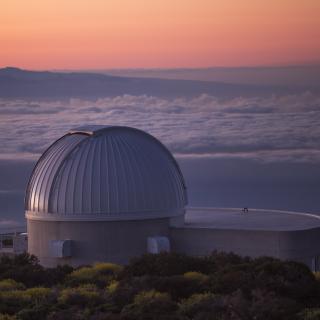
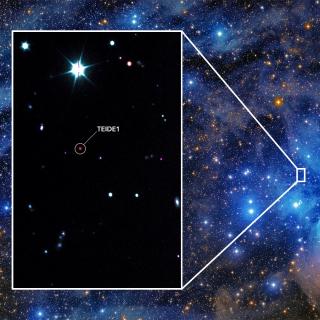
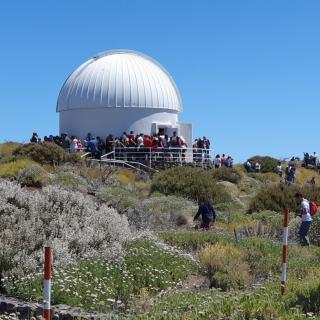
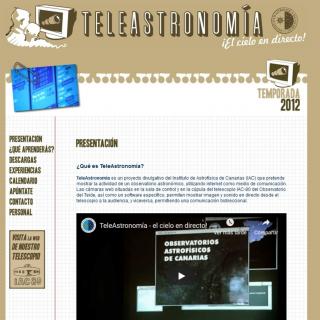
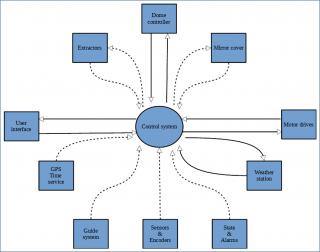
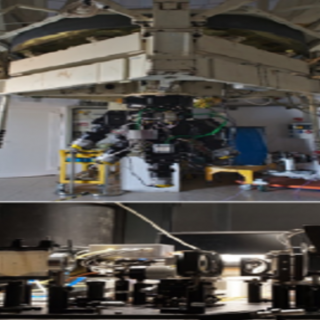
No se ha encontrado ningún resultado.